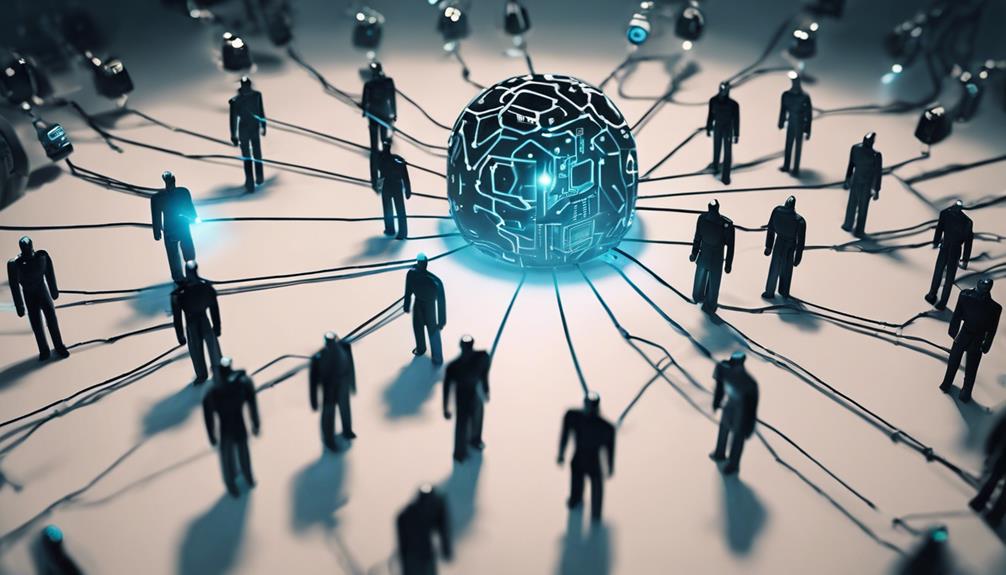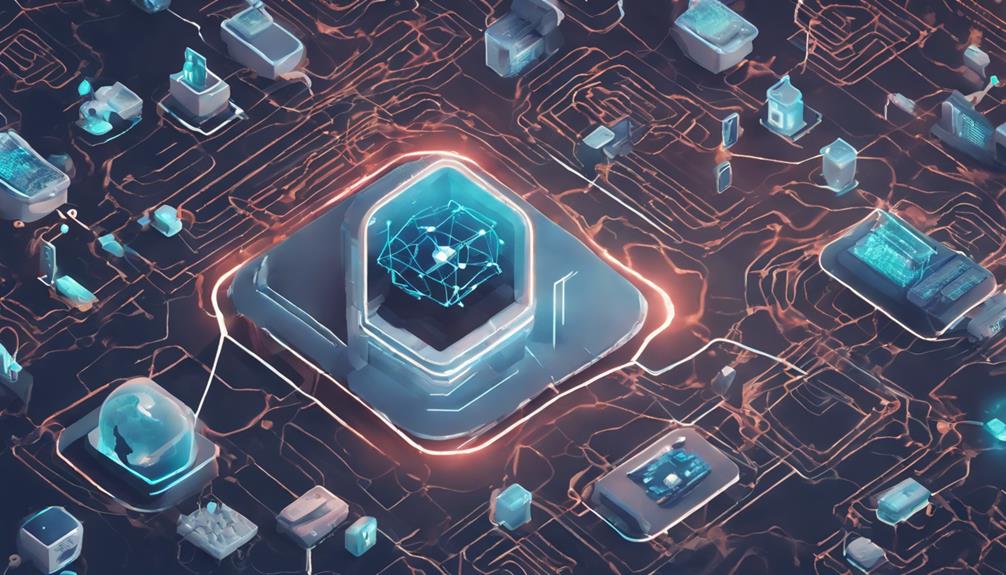Cybersecurity concerns with AI require careful monitoring. Watch for data poisoning, as it skews algorithms, leading to biased outcomes. Lack of transparency in black box models poses challenges, compromising ethical integrity. Guarantee model management for security; control versions, monitor performance, and address vulnerabilities. Safeguard against privacy breaches and insider threats by prioritizing robust security measures. Stay alert to AI-enabled attacks like phishing emails and automated malware. Swiftly detect security breaches with an incident response strategy. Understanding these risks is crucial for protecting AI systems effectively. Additional insights await for a deeper understanding of safeguarding AI in the digital landscape.
Key Takeaways
- Data poisoning risks compromise AI integrity.
- Lack of transparency hinders accountability.
- Model management is crucial for security.
- Privacy concerns demand robust safeguards.
- AI-enabled attacks pose new threats.
Data Poisoning and Bias
Data poisoning and bias pose significant challenges in the domain of cybersecurity, impacting the integrity and reliability of AI algorithms. Data poisoning involves injecting malicious data into the training data of AI systems, leading to algorithmic bias. This bias can result in discriminatory outcomes and flawed decision-making processes, making it essential to detect and mitigate such attacks to maintain the trustworthiness of AI systems in cybersecurity.
Malicious actors can manipulate AI models through data poisoning attacks, causing these systems to make incorrect predictions or provide skewed recommendations. The use of biased data during the training phase can perpetuate and amplify existing prejudices, leading to harmful consequences in various applications.
Safeguarding AI systems against data poisoning and bias is paramount for ensuring the security and fairness of these technologies in cybersecurity settings. By implementing robust detection mechanisms and bias-mitigation strategies, organizations can fortify their AI systems against these insidious threats.
Black Box Models

Black box models in AI present a challenge due to their lack of transparency, making it difficult to comprehend how decisions are reached. This opacity can lead to issues like bias, errors, and unintended consequences, impacting the ethical integrity of AI systems.
Addressing the interpretability of these models is vital for fostering trust, ensuring accountability, and promoting ethical decision-making in AI applications.
Transparency in AI
The opacity of decision-making processes in complex AI algorithms, commonly known as black box models, presents significant challenges in ensuring transparency and accountability within AI systems. Transparency is essential for understanding how AI systems reach conclusions and for identifying any biases or vulnerabilities that may affect their performance.
Without transparency, it becomes difficult to explain the reasoning behind AI decisions, hindering trust and compliance with regulations. Lack of visibility into these decision-making processes can obscure errors and biases, affecting the accuracy and reliability of AI models.
Addressing the black box problem in AI is vital to enhance explainability, mitigate risks, and build user trust in these technologies. By promoting transparency in AI systems, organizations can improve accountability, foster trust among users, and ensure that these technologies operate ethically and effectively.
Establishing clear guidelines for transparency can help address these challenges and promote responsible AI development.
Accountability for Bias
An imperative aspect of ensuring ethical and unbiased AI decision-making resides in addressing accountability for bias within opaque black box models. These models, while powerful, can pose significant challenges due to their lack of transparency. Identifying and addressing biases in AI algorithms becomes a complex task when the inner workings are obscure, potentially leading to discriminatory outcomes that are hard to detect. To enhance accountability and mitigate risks of unjust decisions, efforts must focus on improving interpretability in AI models.
| Key Points | Description |
|---|---|
| Bias Detection | Identifying biases in AI algorithms within black box models is challenging. |
| Accountability Measures | Implementing systems to hold AI accountable for biased outcomes is essential. |
| Ethical Decision-Making | Ensuring fair and ethical decisions, especially in sensitive areas, is crucial. |
Ethical Decision-Making
How can the ethical implications of decision-making in opaque AI models be effectively addressed?
Black box AI models present challenges in ensuring ethical decision-making due to their lack of transparency. The inner workings of these systems are often hidden, making it difficult to understand how decisions are reached. This opacity can lead to biased or discriminatory outcomes, raising concerns about accountability and fairness.
To address these ethical issues, it is essential to promote transparency in AI models. By providing insights into how data is processed and decisions are made, users can better assess the reliability and fairness of the system. Understanding the mechanisms behind AI decisions is vital for preventing unintended consequences and ensuring that ethical standards are upheld.
Inadequate Model Management

Effective model management is vital for the security of AI systems.
Model version control guarantees that the most up-to-date and secure models are in use.
Monitoring model performance helps detect anomalies early to prevent security breaches and maintain system integrity.
Model Version Control
In the domain of AI cybersecurity, the absence of proper model version control can pose significant risks and challenges. Inadequate model management can lead to confusion over the model version in production, hindering timely security updates and patches. This lack of tracking changes leaves AI models vulnerable to exploitation by threat actors, exposing organizations to security vulnerabilities.
Additionally, without a robust model version control system, troubleshooting security incidents becomes challenging as the ability to trace back to specific versions is compromised. As a result, deploying outdated or compromised AI models in cybersecurity defenses becomes a real risk.
Hence, effective model management is essential for maintaining the integrity and security of AI systems in cybersecurity applications. Organizations must prioritize implementing thorough model version control practices to bolster their cyber defenses and safeguard against potential breaches and cyber threats.
Risk of Bias
Inadequate model management in AI systems can result in significant risks associated with bias, impacting the ethical and accurate outcomes of algorithms. Bias in AI models often originates from mishandling training data, with a lack of diversity in datasets leading to skewed predictions and discriminatory behavior.
Addressing bias is important, as failure to do so can result in unfair decision-making processes and negative societal impacts. To mitigate bias effectively, continuous monitoring of AI models is essential. By regularly evaluating and adjusting algorithms, organizations can make sure that ethical standards are met, and outcomes remain accurate and unbiased.
Emphasizing diversity in training data and implementing robust monitoring mechanisms are key steps towards creating more ethical AI models. By proactively managing bias in AI systems, we can aim for fairness and accountability in the deployment of these technologies.
Monitoring Model Performance
Proper monitoring of model performance is essential in maintaining the effectiveness and reliability of AI systems. Inadequate model management can lead to biases and errors in AI systems, impacting their overall cybersecurity posture. Monitoring model performance helps in identifying when retraining or adjustments are necessary to uphold accuracy. Neglecting this vital aspect can result in AI models performing poorly or making inaccurate predictions, ultimately compromising the system's integrity.
To emphasize the significance of monitoring model performance, consider the following table showcasing the potential consequences of inadequate model management:
| Consequences of Inadequate Model Management | ||
|---|---|---|
| AI models perform poorly | Biases in predictions | Errors in system functionality |
| Undetected cybersecurity vulnerabilities | Impact on overall system reliability | Need for frequent retraining |
Privacy Concerns

Privacy implications in AI systems stem from the potential exposure of sensitive information, posing risks of breaches, scams, and social engineering attacks. These privacy risks highlight the importance of implementing robust security measures to safeguard against unauthorized access and privacy violations.
Data breaches in AI can have severe consequences, especially when detailed profiles can be constructed through data combination due to challenges in data anonymization. The complexity of AI models, often perceived as black boxes, can further exacerbate privacy concerns by making it challenging to explain their behavior, potentially leading to privacy breaches.
It is essential to prioritize consent management in AI to guarantee ethical use of personal data with user permission, thereby reducing the risk of privacy violations. Additionally, stringent data access controls and compliance with privacy regulations are vital in mitigating privacy risks, preventing the misuse of personal data by third parties on AI platforms.
Model Security Risks

Security vulnerabilities inherent in AI models can pose significant risks to the integrity and reliability of these systems. When considering model security risks in AI development, it's essential to be aware of potential threats and take proactive measures to safeguard against them.
Here are key points to understand:
- Vulnerabilities in Software:
Weaknesses in the code or architecture of AI models can be exploited by malicious actors to compromise the system.
- Data Poisoning:
Manipulating training data to introduce biases or influence model behavior can lead to inaccurate outputs and decisions.
- Unauthorized Access:
Unauthorized users gaining access to AI models can result in data breaches, manipulation of outcomes, or theft of sensitive information.
- Machine Learning Risks:
The dynamic nature of machine learning models can make them susceptible to adversarial attacks and other security threats.
To mitigate these risks, organizations must prioritize secure AI model development, implement robust authentication mechanisms, and regularly assess and address potential vulnerabilities.
AI-Enabled Attacks

Addressing the intersection of AI and cybersecurity, a growing concern emerges with the rise of AI-enabled attacks leveraging machine learning and automation to execute sophisticated cyber threats. These attacks, powered by AI, encompass a range of malicious activities such as AI-generated phishing emails, automated malware creation, and targeted social engineering. Adversaries utilize AI to circumvent traditional security defenses, evade detection mechanisms, and amplify the impact of their assaults.
By leveraging machine learning, AI-powered attacks can learn from defenders' responses, adapt their strategies, and exploit vulnerabilities more efficiently. Consequently, defending against AI-enabled attacks necessitates the implementation of advanced cybersecurity measures, continuous monitoring practices, and the adoption of adaptive threat detection strategies.
As the threat landscape evolves, organizations must stay vigilant, enhancing their cybersecurity posture to combat these sophisticated and adaptive threats effectively. By understanding the mechanisms behind AI-enabled attacks and investing in robust defense mechanisms, businesses can better protect their sensitive data and infrastructure from cyber threats.
Insider Threats

In organizations, the risk of insider threats in cybersecurity involving employees, contractors, or partners exploiting access privileges for malicious activities is a pressing concern.
When it comes to insider threats and AI, several key points should be considered:
- Detection with AI: AI can analyze user behavior, access patterns, and data exfiltration attempts to identify potential insider threats effectively.
- Risk of Data Exfiltration: Insider threats with AI may involve the theft of sensitive data, sabotage of systems, or unauthorized disclosure of confidential information.
- Monitoring User Activities: AI tools can continuously monitor user activities, flag any unusual behaviors, and provide real-time alerts to mitigate potential insider threats promptly.
- Need for Response Mechanisms: Insider threats pose a significant risk to organizations, emphasizing the importance of implementing AI-powered detection and response mechanisms to safeguard against such risks effectively.
Incident Response Strategy

Effective management of cybersecurity incidents involving AI systems requires a well-defined incident response strategy. Organizations must be prepared to detect, contain, and mitigate security breaches promptly to safeguard their AI systems. Prioritizing incident response training and preparation is essential to effectively handle AI-specific threats. Incident response teams need to be equipped to analyze data and respond to AI-generated attacks in real-time, ensuring swift action against potential threats. Proactive incident response strategies play a critical role in minimizing the impact of AI-related cybersecurity incidents on organizations, emphasizing the importance of staying ahead of potential risks.
| Key Strategies | Benefits |
|---|---|
| Detect AI security breaches promptly | Early identification of threats |
| Contain and mitigate threats swiftly | Limit damage and prevent escalation |
| Prioritize incident response training | Enhance preparedness and response capabilities |
| Implement proactive strategies | Minimize impact of cybersecurity incidents |
Frequently Asked Questions
What Are the Cyber Security Risks of Ai?
AI in cybersecurity presents risks such as data breaches, adversarial attacks, and vulnerabilities in AI-generated code. Adversaries exploit weaknesses to manipulate decisions or automate attacks. Misuse can lead to copyright violations and reputation damage. AI infrastructure vulnerabilities are critical.
What Is the Main Challenge of Using AI in Cybersecurity?
The main challenge of using AI in cybersecurity lies in its susceptibility to exploitation by adversaries. Vulnerabilities in AI systems can be manipulated, leading to breaches and data compromises, posing a significant threat to security measures.
How Does AI Raise Security Concerns?
AI raises security concerns by introducing vulnerabilities in systems, allowing for unexpected functions and potential exploits by malicious actors. Data poisoning can manipulate AI behavior, impacting algorithm reliability. Robust security measures are essential to safeguard AI systems in critical functions.
Can AI Overtake Cyber Security?
In the dynamic landscape of cybersecurity, the question arises: can AI overtake cyber security? As AI evolves, it presents both promise and peril. Vigilance, adaptive strategies, and a human touch are crucial to guarantee AI serves as a cyber ally, not a threat.
What Is the Main AI Use Case in Cybersecurity?
The main use case of AI in cybersecurity revolves around threat detection, anomaly detection, predictive analysis of cyber threats, malware analysis, and automation of security tasks like phishing detection and incident response, collectively strengthening overall cybersecurity capabilities.
Conclusion
In the ever-evolving landscape of cybersecurity, managing the potential risks of AI requires vigilance and strategic planning.
Just as a skilled sailor must steer through turbulent waters with precision and caution, organizations must be prepared to address data poisoning, bias, black box models, and other threats.
By implementing robust incident response strategies and staying informed on emerging cybersecurity trends, businesses can steer clear of potential dangers and safeguard their valuable data.









